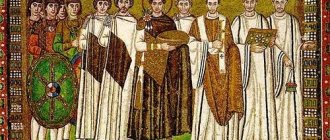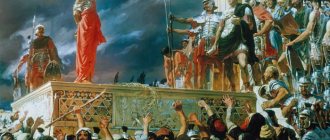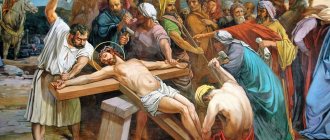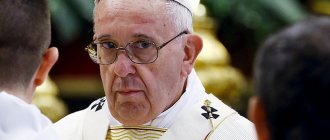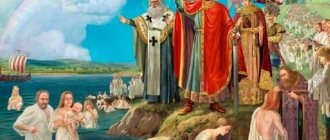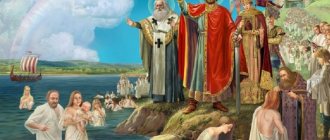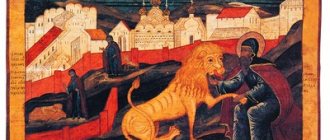The theme of Constantinople and Constantinople haunted the rulers of the Russian state for centuries. At first the rich city was a desirable object of robbery. Then he became a supplier of status brides. And after the capture of Constantinople by the Ottomans, Moscow started talking about the godly goal of recapturing such a holy place for the Orthodox. During the reign of Catherine II, after a series of victories over the Turks, a whole project for the revival of Byzantium matured in St. Petersburg. And by the end of the reign of Nicholas II, it seemed to many that the dream of turning Istanbul and the straits into the patrimony of the Russian Empire was about to turn into reality. But alas. It didn't come true...
From wild barbarians to enlightened Christians
The first campaign of the northern neighbors to the famous city took place in the 9th century. Scientists are still arguing about the exact dates. But the very acquaintance of the Rus tribe with the Orthodox traditions of Byzantium was of a specific nature. As the author of “The Life of St. George of Amastrida” reported, the aliens “overthrew temples and desecrated shrines.” It was impossible to imagine that the descendants of the arriving barbarians would become zealous champions of Christianity. For they “mercilessly slaughtered every sex and age, not sparing old men and infants, but hastening to bring death everywhere.”
The death of the Russian fleet near Constantinople in 860. (Wikimedia Commons)
As usual, there were some miracles. When the Russian soldiers decided to open the tomb of St. George, their arms and legs were paralyzed. The leader of the barbarians was so amazed at the power of the Christian God that he immediately ordered all the looted treasures to be returned to the church and the captives to be released. And then the numb limbs of the warriors regained mobility. The frightened barbarians immediately left the blessed shores and sailed away.
Apparently, in the north, many decided to experience the inevitability of punishment for anyone who dares to encroach on Christian churches. And the military campaigns of the inhabitants of Ancient Rus' against Constantinople were repeated several more times. Moreover, the most famous of them, when supposedly the Prophetic Oleg nailed his shield to the gates of Constantinople, is mentioned only in Russian chronicles.
Capital symbols
Constantinople is a city of secret meanings. Local guides will definitely show you the two main attractions of the ancient capital of Byzantium - Hagia Sophia and the Golden Gate. But not everyone will explain their secret meaning. Meanwhile, these buildings did not appear in Constantinople by chance.
Hagia Sophia and the Golden Gate clearly embodied medieval ideas about the wandering City, especially popular in the Orthodox East. It was believed that after ancient Jerusalem lost its providential role in the salvation of mankind, the sacred capital of the world moved to Constantinople. Now it was no longer the “old” Jerusalem, but the first Christian capital that personified the City of God, which was destined to stand until the end of time, and after the Last Judgment to become the abode of the righteous.
Fashion for Greek wives
And yet, regular contacts with Byzantium, albeit through predatory raids, did not pass without a trace for the Rus. A prince named Vladimir was so imbued with the power of faith that in 988 he ordered the inhabitants of his domain to be baptized. True, evil tongues claimed that he was motivated by purely practical considerations. As a military leader, he was obliged to confirm his leadership by personal participation in battles (which became increasingly difficult over the years). But as God’s anointed, he was already turning his power into one granted to him by God himself, which eliminated the need to participate in military exploits. And it almost guaranteed the transfer of power to direct descendants.
Vladimir's campaign against Korsun in 988. (Wikimedia Commons)
Just a little bit was not enough to turn from the first among equals in the eyes of his comrades into an unattainable ruler. A status wife was needed. Not the daughter of the same yesterday’s pagan prince. And definitely a Byzantine princess. It doesn’t matter that Vladimir was already married (more than once). Such trifles did not bother the newly converted Christian. And he achieved his goal! The marriage to the imperial daughter named Anna must have made a strong impression in Ancient Rus'. Any ugly girl from Constantinople was much more prestigious than a beautiful princess from Scandinavia or Transcarpathia.
For many years, none of Vladimir’s descendants managed to repeat this trick. Therefore, the fall of Constantinople was a real gift for Grand Duke Ivan III. The niece of the last emperor of Byzantium, left without a homeland, did not become capricious when she was offered to marry a widower from distant Muscovy. In 1472, 18-year-old Sophia Paleologus came to Russia. To celebrate this event, the idea was quickly born that Moscow was the Third Rome (Constantinople was considered the second) and the stronghold of the true faith.
"Greek Project"
The theme of Byzantium again became relevant in the second half of the 18th century. The incredible successes of Russian weapons in the wars with the Ottoman Empire gave rise to a bold project for the final defeat and division of the possessions of the Turkish Sultan. To create a new Byzantium from Greece and Asia Minor with its capital in Constantinople. The main ideologist of the project was Catherine II. The Empress approached the implementation of her plan so responsibly that she insisted on the Greek name Constantine, uncharacteristic among representatives of the Romanov dynasty, for her second grandson. The queen already saw him as the ruler of a revived power, sitting on the throne of Constantinople. At the same time, new Russian cities in the south began to be called in the Greek manner.
Of course, the ruler of Russia declared her plan as a noble cause of saving the ancestral Christian lands from the Islamic yoke. There was no talk of any insidious intentions to occupy the straits, so valuable for the free passage of the Russian fleet into the Mediterranean Sea.
Scheme of the straits. ("Amateur")
Catherine was a reasonable politician and understood well that first it was necessary to come to an agreement with other European sovereigns. But the negotiations quickly reached a dead end. Everyone agreed that the Sultan's Christian subjects were being cruelly oppressed and needed to be freed. But it was not possible to agree on whose relatives would sit on such a tempting throne.
The solution to the “Eastern Question” was postponed for decades. The rulers of the leading powers of Europe periodically artificially supported the existence of the dying Ottoman Empire. Just to prevent foreign influence from strengthening its position in Turkish territories. Emperor Nicholas I even sent a Russian fleet and army to help the Sultan during the uprising in Egypt.
The failure of European monarchs to reach an agreement ultimately cost the Christians of the Ottoman state dearly.
Dawn of Constantinople
At the direction of Constantine, the best sculptures, valuable manuscripts, church utensils, and relics of saints were taken from Rome, Athens, Corinth, Ephesus, Antioch and other cities of the empire to Constantinople. Constantine's work was continued by his descendants. Marble and copper columns that previously adorned Roman temples and squares were brought to Constantinople.
Tradition says that 60 tons of gold were spent on the construction of the city. Subsequently, the city grew and developed so rapidly that half a century later, during the reign of Emperor Theodosius, new city walls were erected, which have survived to this day, and included seven hills - the same as in Rome.
During the reign of Emperor Justinian in 527–565, the largest Nika uprising broke out in the city. The city was significantly destroyed, Hagia Sophia burned down.
After the brutal suppression of the rebellion, Justinian rebuilt the capital, attracting the best architects of his time. A “golden age” begins for Constantinople. New buildings, temples and palaces are being built, the central streets of the new city are decorated with colonnades. A special place is occupied by the construction of Hagia Sophia, which became the largest temple in the Christian world and remained so for more than a thousand years - until the construction of St. Peter's Basilica in Rome.
The city grows rapidly and becomes first the business center of the then world, and soon the largest city in the world.
In Russia, the city was given its name - Tsargrad - the city where the king lives . And the word “king” itself may have come from the name of the Roman emperor Julius Caesar. The word "Caesar" became part of the title of the Roman emperors.
The wealth of the city aroused the envy of the surrounding peoples. Between 666 and 950 the city was subject to repeated sieges by the Arabs.
Serious intentions
Throughout the end of the 19th century, the Ottoman Porte continued to weaken. It was rocked by uprisings, and islands of separatism appeared on the outskirts. By the beginning of the 20th century, the Sultan had lost almost all of his possessions in Europe. It seemed that only a small effort was needed to return Constantinople to Christian rule.
Constantinople, 1910. (clio-historia.livejournal.com)
Nicholas II, who sat on the Russian throne in 1894, immediately had to make a decision about a possible attack on Istanbul. The General Staff developed a detailed plan. Six squadron battleships and more than forty other ships were to take part in the operation. The landing force included 35 thousand soldiers. In case of British intervention, provisions were made for a march to British India from Central Asia.
Finance Minister Sergei Witte, who at that time had enormous influence on the tsar, sharply opposed these plans. And Nicholas II at the last moment ordered to cancel the attack.
How Byzantium was founded
The history of the founding of Byzantium is reflected in ancient mythology. According to legend, the beloved of the supreme god Zeus, the beautiful Io (daughter of the river god and king of the city of Argos Inach), hiding from the pursuit of the vengeful Hera, took refuge in the vicinity of the Golden Horn Bay. Here her daughter Keroessa was born.
From the union of Keroessa and the god Poseidon, the son Byzantium was born, who later became the first king of the city of Byzantium, which he founded. This happened in 667 BC. According to the custom of those years, before embarking on the implementation of any serious plan, one should receive guidance from the Delphic Oracle.
The oracle gave advice to “settle opposite the blind.” Having carefully examined the area, Byzant considered that it was best to found a city opposite the settlement of Chalcedon, since only “blind” people could be who did not notice the peninsula located on the shores of the Bosporus Strait, the Sea of Marmara and Krivoy Rog Bay.
The location chosen for the city gave him the opportunity to control the movement of goods flowing both from Asia to Europe and in the opposite direction, which was a reliable source of replenishment of the state treasury. In addition, trade flourished in Byzantium itself, which contributed to the development of the city.
At the same time, the fortunate geographical and strategic location was the reason for frequent armed attacks on Byzantium.
History of Constantinople
The year 324 became a new milestone in the history of Byzantium. After a series of internecine wars, the Roman Emperor Constantine the Great began a grandiose reconstruction of the city. Very soon, the construction of fortress walls began around the city, new palaces appeared in it, a colossal Church of the Apostles, and the hippodrome was rebuilt.
In May 330, Constantine the Great officially announced the transfer of the capital to a strategic peninsula near the Bosphorus Strait and the renaming of Byzantium. The new capital of the empire was given the name New Rome. However, this name was not destined to gain a foothold in history for long. Everyone began to call the city Constantinople, in honor of Constantine, who founded it.
Grateful Steps on the Path to Greatness
In an effort to ensure that the new capital amazed everyone with its splendor, Constantine did the following:
1. Contributed in every possible way to population growth due to migrants from Asia and Europe. To attract an influx of migrants, he ordered that new arrivals be provided with free wine, bread, oil and fuel. The settlers enjoyed a number of benefits.
2. Skilled architects, masons, carvers, sculptors, painters, carpenters were invited to Constantinople: everyone who, with their art, could contribute to increasing its splendor. All artisans in this category were exempted from performing all state duties.
3. In accordance with the order of the emperor, religious shrines were imported to Constantinople: precious cult paraphernalia, relics of the holy great martyrs, priceless volumes, and skillful sculptures. All this was collected in the cities of the Roman Empire: Rome, Athens, Ephesus, Corinth. No city was to surpass the capital.
4. Arts and sciences flourished in Constantinople. It was a city of scientists and thinkers. The libraries of that time amazed with the richness of their collections, numbering hundreds of ancient manuscripts.
After the death of Constantine, his successors also spared no expense in maintaining the splendor of the capital. After 50 years, the city's territory covered seven hills (as in Rome) and was surrounded by high fortress walls. There were rumors that more than sixty tons of gold were spent during the construction of the city: these were colossal expenses for those times.
The result exceeded all expectations: Constantinople amazed with the beauty of its temples, palaces, the width of its streets with covered galleries, huge squares decorated with triumphal arches, sculptures, marble and copper columns taken from Rome itself.
